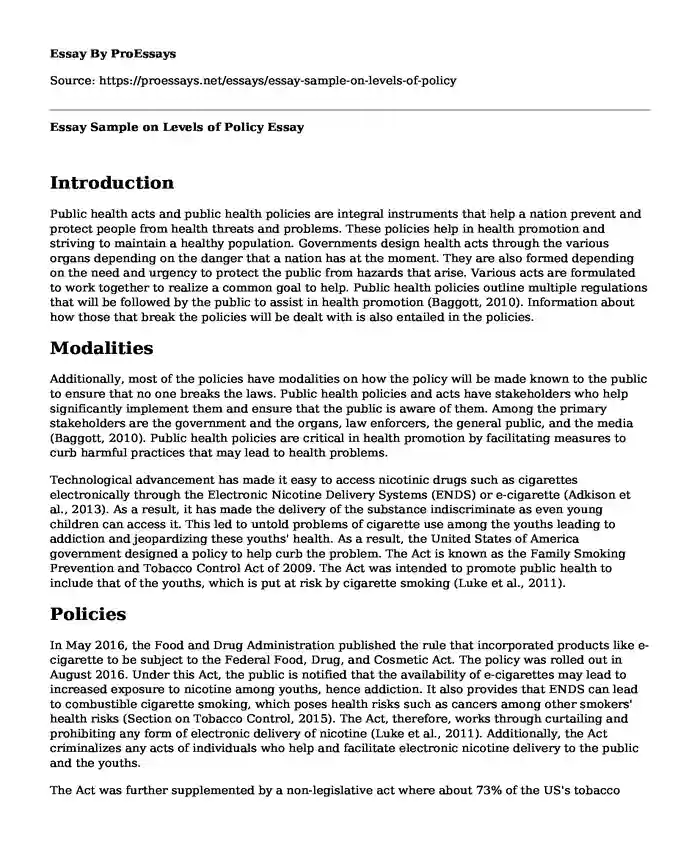Introduction
Public health acts and public health policies are integral instruments that help a nation prevent and protect people from health threats and problems. These policies help in health promotion and striving to maintain a healthy population. Governments design health acts through the various organs depending on the danger that a nation has at the moment. They are also formed depending on the need and urgency to protect the public from hazards that arise. Various acts are formulated to work together to realize a common goal to help. Public health policies outline multiple regulations that will be followed by the public to assist in health promotion (Baggott, 2010). Information about how those that break the policies will be dealt with is also entailed in the policies.
Modalities
Additionally, most of the policies have modalities on how the policy will be made known to the public to ensure that no one breaks the laws. Public health policies and acts have stakeholders who help significantly implement them and ensure that the public is aware of them. Among the primary stakeholders are the government and the organs, law enforcers, the general public, and the media (Baggott, 2010). Public health policies are critical in health promotion by facilitating measures to curb harmful practices that may lead to health problems.
Technological advancement has made it easy to access nicotinic drugs such as cigarettes electronically through the Electronic Nicotine Delivery Systems (ENDS) or e-cigarette (Adkison et al., 2013). As a result, it has made the delivery of the substance indiscriminate as even young children can access it. This led to untold problems of cigarette use among the youths leading to addiction and jeopardizing these youths' health. As a result, the United States of America government designed a policy to help curb the problem. The Act is known as the Family Smoking Prevention and Tobacco Control Act of 2009. The Act was intended to promote public health to include that of the youths, which is put at risk by cigarette smoking (Luke et al., 2011).
Policies
In May 2016, the Food and Drug Administration published the rule that incorporated products like e-cigarette to be subject to the Federal Food, Drug, and Cosmetic Act. The policy was rolled out in August 2016. Under this Act, the public is notified that the availability of e-cigarettes may lead to increased exposure to nicotine among youths, hence addiction. It also provides that ENDS can lead to combustible cigarette smoking, which poses health risks such as cancers among other smokers' health risks (Section on Tobacco Control, 2015). The Act, therefore, works through curtailing and prohibiting any form of electronic delivery of nicotine (Luke et al., 2011). Additionally, the Act criminalizes any acts of individuals who help and facilitate electronic nicotine delivery to the public and the youths.
The Act was further supplemented by a non-legislative act where about 73% of the US's tobacco states supported the ban on smoking in restaurants, enclosed places, and other public areas (Cummings & Proctor, 2014). The measure also helped curb e-cigarette among the youths hence promoting their health and the entire wellness of the public from the dangerous effects that active and passive smoking cause to the people.
Conclusion
Thus, this non-legislative Act works by prohibiting combustive smokers from smoking in public places to reduce passive smoking on non-smokers in those public places. Additionally, this Act helps educate the public on the dangers that one puts themselves in when they smoke, but does not criminalize smoking or prohibit smoking among smokers (Cummings & Proctor, 2014). Policies such as these are useful in helping the prevention of nicotine abuse among the youths and the entire public.
References
Adkison, S. E., O'Connor, R. J., Bansal-Travers, M., Hyland, A., Borland, R., Yong, H. H., ... & Fong, G. T. (2013). Electronic nicotine delivery systems: international tobacco control four-country survey. American journal of preventive medicine, 44(3), 207-215.
Baggott, R. (2010). Public health: policy and politics. Macmillan International Higher Education.
Cummings, K. M., & Proctor, R. N. (2014). The changing public image of smoking in the United States: 1964–2014. Cancer Epidemiology and Prevention Biomarkers, 23(1), 32-36.
Luke, D. A., Ribisl, K. M., Smith, C., & Sorg, A. A. (2011). Family Smoking Prevention And Tobacco Control Act: banning outdoor tobacco advertising near schools and playgrounds. American journal of preventive medicine, 40(3), 295-302.
Section on Tobacco Control. (2015). Electronic nicotine delivery systems. Pediatrics, 136(5), 1018-1026.
Cite this page
Essay Sample on Levels of Policy. (2024, Jan 11). Retrieved from https://proessays.net/essays/essay-sample-on-levels-of-policy
If you are the original author of this essay and no longer wish to have it published on the ProEssays website, please click below to request its removal:
- Paper Example on Different Sugars
- Pathophysiology Assessment Case Study
- A Summary of IOM's Report and its Significance to Nursing - Essay Sample
- Essay Sample on Crisis Ahead: Nursing Shortage Impacts Healthcare Business
- Marijuana: Adverse Effects Despite Potential Benefits - Essay Sample
- Essay Sample on Drug Info: Misleading Consumers or Evidence-Based?
- Disseminated Intravascular Coagulation - Free Essay







